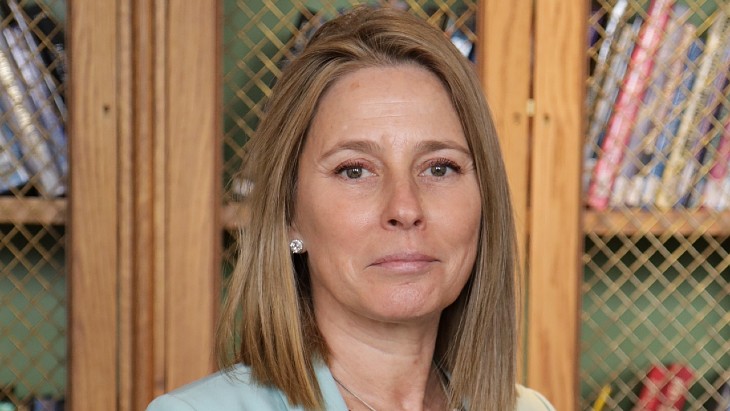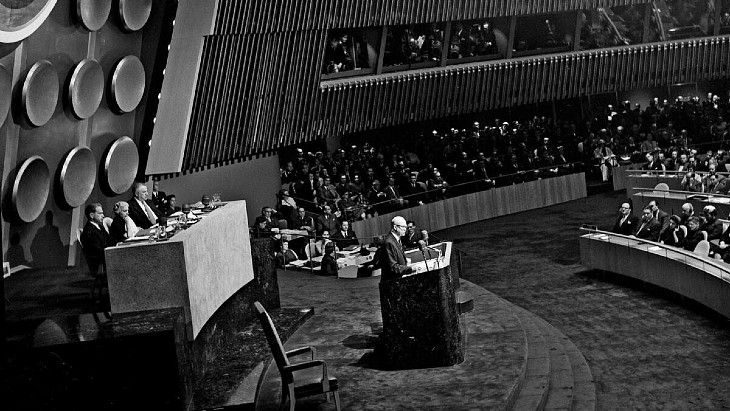Ladies and gentlemen, esteemed guests, and fellow advocates for a brighter future, it is an honour to stand before you today at this historic conference, commemorating seven decades of the enduring legacy of Atoms for Peace. Today, we gather not just to reflect on the past but to chart the course for a future energised by the transformative potential of nuclear energy.
Seventy years ago, in 1953, President Dwight D Eisenhower delivered his historic Atoms for Peace speech.
On that day, he set out a vision to harness the power of the atom for the betterment of humanity, setting the stage for international cooperation in the pursuit of peace and prosperity - a vision that has grown into a lasting legacy.
As we know, "it only takes one seed to grow a forest", and now, as we reflect on the past 70 years, we see that Eisenhower's vision has indeed germinated into a forest of possibilities for the peaceful uses of nuclear applications.
Looking back, we have witnessed remarkable achievements in the peaceful application of nuclear technology. From powering our cities to advancing medical diagnostics and treatment, nuclear technology has become an indispensable ally in our pursuit of a brighter, sustainable, future.
Today there are 436 nuclear power reactors operating, and 213 more reactors that did operate for many years and are now shutdown. All of these together have provided people in more than 30 countries with clean, reliable, and affordable electricity. Over the past 50 years they have avoided the emission of 80 billion tonnes of carbon dioxide, more than twice the total amount of carbon dioxide emitted globally each year.
 Bilbao y León says 'we must dream big and work tirelessly to transform those dreams into reality' (Image: WNA)
Bilbao y León says 'we must dream big and work tirelessly to transform those dreams into reality' (Image: WNA)
Beyond power generation, the world has seen more than 800 research reactors operate in 53 countries, in universities and research institutes, expanding our knowledge and the uses of nuclear science and technology for the benefit of humanity. Research and development are fundamental to the nuclear sector, with nuclear techniques reaching all areas of our lives: agriculture and the food we eat, historical and geological measurements, and producing life-saving medical radioisotopes.
Lloyd's Register also shows that some 700 maritime nuclear reactors have been used at sea since the 1950s. Combined with land-based power and research reactors, that is more than 2000 nuclear reactors with tens of thousands of years of operating experience that have operated since that original seed was planted 70 years ago.
Moreover, nuclear technology has ventured beyond land and sea, and even beyond our planet, supporting space exploration missions, demonstrating the versatility and adaptability of nuclear technology. Radioisotope thermoelectric generators, or RTGs, have powered a number of space missions and continue to propel human exploration beyond the realms of our solar system, with the Voyager space probes transmitting information back to earth since 1977, thanks to the power of nuclear technology.
From Apollo, Pioneer, Galileo, Cassini, and New Horizons space missions and the Martian rovers, Curiosity and Perseverance, nuclear technology is at the forefront of humanity’s quest for knowledge and exploration.
However, as we stand on the shoulders of all these significant accomplishments, we must also acknowledge the missed opportunities. Had we expanded the use of nuclear energy as fast and as widely as we originally planned, humanity might not be facing the climate crisis we are confronting today. Climate change is now an urgent threat to both the planet and humanity.
For many years nuclear power plants have been the backbone of electricity generation, powering homes and industries around the world while significantly reducing greenhouse gas emissions. They have brought energy security, helping nations reduce their dependence on fossil fuels and stabilise their grids.
But our vision extends beyond power generation. It encompasses a holistic approach to energy and sustainability, embracing non-power applications of nuclear technology. From hydrogen production, and water desalination to cogeneration for industrial processes and more. Nuclear innovation holds the key to unlocking a myriad of possibilities. The potential of nuclear energy extends far beyond what we have achieved to date.
Looking forward, we must paint an ambitious outlook for the nuclear sector, one that honours Eisenhower's vision and prepares us for the challenges and opportunities of the 21st century. The legacy of Atoms for Peace must inspire us to increase the contribution of nuclear for a better and brighter world. We must dream big and work tirelessly to transform those dreams into reality.
So, what are the key actions for us today that will lead us into this brighter future?
- First, safety and security will remain paramount. Our commitment to non-proliferation and safeguards is unwavering and was a pillar of the Atoms for Peace vision. We must continuously invest in research and development to enhance the safeguarding of nuclear materials.
- Second, we must prioritise sustainability. We know well the contribution of nuclear to mitigating climate change. Our actions must reflect a profound commitment to reducing impacts on the environment, by extending the life of existing nuclear power plants we can maximise 24/7 clean energy contributions. The continued presence and integration of nuclear energy into a broader energy mix, alongside renewables, can help us achieve a more resilient, low-carbon future.
- Third, innovation is the lifeblood of progress. We must accelerate the development and deployment of the next generation of reactor designs, such as small modular reactors and advanced-generation technologies, which promise enhanced efficiency, and applications beyond electricity. Let us also harness the power of technology outside of the nuclear sector, like artificial intelligence, automation, additive manufacturing and advanced materials to revolutionise the nuclear industry.
- Fourth, we must promote international collaboration. Nuclear energy knows no borders, and our collective success depends on our shared knowledge and experience. The legacy of Atoms for Peace calls upon us to work together, transcending geopolitical divides, to tackle global challenges like climate change and socio-economic inequity. We will succeed together or we will fail separately.
- Lastly, we must engage the public. Transparency, open dialogue and education are essential in dispelling misconceptions and building public trust in nuclear energy. An informed public can better appreciate the positive impact of nuclear technology on our world.
Progress in these key areas of nuclear energy: security, sustainability, innovation, collaboration, and communication, can help advance our contribution to a brighter future for all. The challenges ahead are formidable, but so is our collective resolve.
I am speaking to you from COP28 in Dubai. This has been a very positive COP in which nuclear energy has been very visible. We saw something that has never happened at a COP before. Eight heads of state, and many more ministers, totalling 22 countries in 4 continents, openly declared their intention to work towards a goal of tripling global nuclear capacity by 2050.
And during the first ever COP Presidency event dedicated to nuclear energy, I had the honour and the pleasure to launch the Net Zero Nuclear Industry Pledge, Endorsed by more than 120 companies, headquartered in 25 countries, and active in over 140 nations worldwide, matching the ambition and pragmatism shown by the 22 governments which signed the Nuclear Ministerial Declaration earlier in the week.
Both the Ministerial Declaration and the Net Zero Nuclear Industry Pledge are more than a mere numerical target but a call to join efforts in materialising the full potential of nuclear energy. By tripling our capacity, we can amplify our impact on climate change mitigation, energy security, and technological innovation.
If we can achieve this feat together, overcoming barriers and challenges to extend and deploy nuclear energy and technology for a brighter future - then in 2050, when we look back 27 years, we will remember this moment as another marker of significance in the race to net-zero electrons and molecules.
The discovery and harnessing of the atom is considered one of the greatest achievements of humankind in the 20th Century. Let the 21st Century see full utilisation of the atom to attain a decarbonised planet and sustainable development for all.
As we commemorate the 70th anniversary of President Eisenhower's visionary speech, Atoms for Peace, let us acknowledge the remarkable progress we've made, but let’s also recognise the challenges that lie ahead. Our commitment to Eisenhower's legacy drives us to ensure that nuclear energy remains a cornerstone of peace, prosperity, and sustainability for generations to come. Together, we can transform its promise into a living legacy - a legacy that transcends borders and benefits all of humanity.
Let us dream big, work tirelessly, and transform those dreams into reality, for the legacy of Atoms for Peace is a legacy of hope, progress, and a better world for all.
Thank you.






_63865.jpg)
_18570.jpg)
_16159.jpg)



